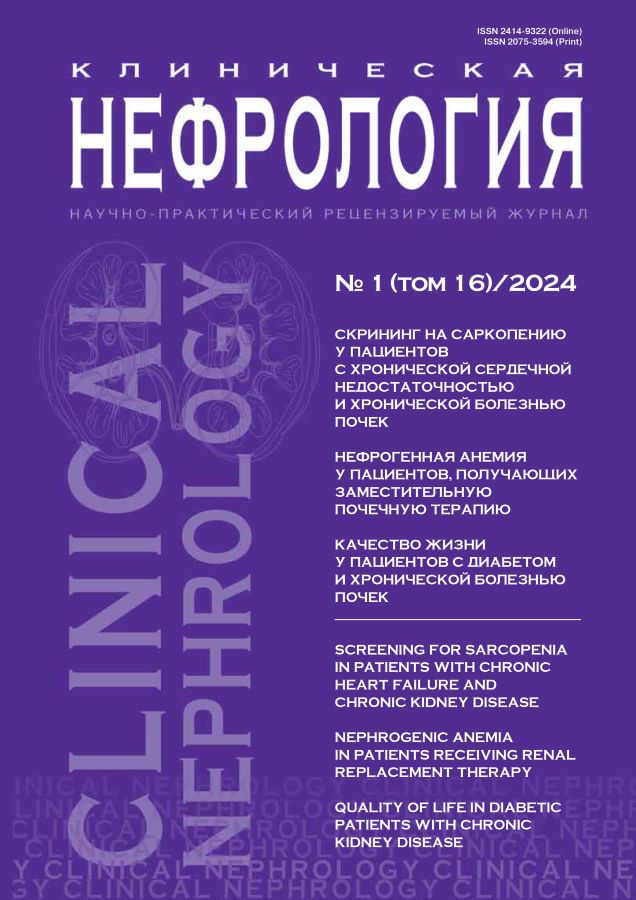Screening for sarcopenia in patients with chronic heart failure and chronic kidney disease
- Авторлар: Sokolova A.V.1,2, Dragunov D.O.1,2, Arutyunov G.P.1
-
Мекемелер:
- Pirogov Russian National Research Medical University
- Research Institute for Healthcare Organization and Medical Management of the Moscow Healthcare Department
- Шығарылым: Том 16, № 1 (2024)
- Беттер: 25-29
- Бөлім: Original Articles
- ##submission.datePublished##: 26.04.2024
- URL: https://journals.eco-vector.com/2075-3594/article/view/631113
- DOI: https://doi.org/10.18565/nephrology.2024.1.25-29
- ID: 631113
Дәйексөз келтіру
Аннотация
Objective. Comparative assessment of the SARC-F questionnaire with a standard measurement of hand grip strength in the context of screening for sarcopenia in patients with chronic heart failure (CHF) and chronic kidney disease (CKD).
Material and methods. A single-center, prospective, non-randomized study was conducted at the Veterans Affairs Hospital №3 of the Moscow Healthcare Department in the period from 2021 to 2022. 105 patients aged 70 (61–78) years with CHF and CKD were included. Half of the participants had 3–4 functional class (FC) of CHF, the rest had 1–2 FC. Approximately equal numbers of patients had different stages of CKD. All patients were diagnosed with sarcopenia according to the EWGSOP2 algorithm. For statistical analysis of the obtained data, the R language was used.
Results. According to the SARC-F questionnaire, 53% of participants scored ≥4 points. Among them, all (100%) experienced shortness of breath, 86% had edema of the lower extremities, 27% had ascites and 38% had pulmonary rales. In patients with lower SARC-F scores, these symptoms were less common. Decreased muscle strength was found in 38% of patients, with those who scored ≥4 points on the SARC-F having lower levels of grip strength. Sarcopenia was detected in 14.3% of patients with SARC-F≥4 and in 8.6% with SARC-F<4, indicating the importance of the SARC-F questionnaire as an indicator of sarcopenia. Analyzing grip strength and SARC-F data, we found a negative correlation in women (r=-0.34; P=0.0083) and no correlation in men (r=0.03; P=0.85). Age was also found to be weakly correlated with grip strength and SARC-F in both men and women. This highlights differences in SARC-F sensitivity and grip strength by patient gender and age.
Conclusion. The study results confirm the effectiveness of the SARC-F as a rapid and accessible tool for the early detection of sarcopenia in patients in this category.
Негізгі сөздер
Толық мәтін
Авторлар туралы
Anna Sokolova
Pirogov Russian National Research Medical University; Research Institute for Healthcare Organization and Medical Management of the Moscow Healthcare Department
Email: tamops2211@gmail.com
Cand.Sci. (Med.), Associate Professor, Associate Professor at the Department of Propaedeutics of Internal Diseases, Pediatric Faculty, Pirogov Russian National Research Medical University; Leading Specialist at the Organizational and Methodological Department for Therapy, Research Institute for Healthcare Organization and Medical Management of the Moscow Healthcare Department
Ресей, Moscow; MoscowDmitry Dragunov
Pirogov Russian National Research Medical University; Research Institute for Healthcare Organization and Medical Management of the Moscow Healthcare Department
Хат алмасуға жауапты Автор.
Email: tamops2211@gmail.com
Cand,Sci. (Med.), Associate Professor, Associate Professor at the Department of Propaedeutics of Internal Diseases, Pediatric Faculty, Pirogov Russian National Research Medical University; Head of the Organizational and Methodological Department for Therapy, Research Institute for Healthcare Organization and Medical Management of the Moscow Healthcare Department
Ресей, Moscow; MoscowGrigory Arutyunov
Pirogov Russian National Research Medical University
Email: tamops2211@gmail.com
Dr.Sci. (Med.), Professor, Corresponding Member of RAS, Head of the Department of Propaedeutics of Internal Diseases, Pediatric Faculty
Ресей, MoscowӘдебиет тізімі
- Troutman A.D., et al. Skeletal muscle atrophy in clinical and preclinical models of chronic kidney disease: A systematic review and meta‐analysis. J. Cachexia Sarcopenia Muscle. 2023. P. jcsm.13400.
- Cruz-Jentoft A.J., et al. Sarcopenia: revised European consensus on definition and diagnosis. Age Ageing. 2019;48(1):16–31.
- Locquet M., et al. Comparison of the performance of five screening methods for sarcopenia. CLEP. 2017;10:71–82.
- Maxim L.D., Niebo R., Utell M.J. Screening tests: a review with examples. Inhalat. Toxicol. 2014;26(13):811–28.
- Malmstrom T.K., Morley J.E. SARC-F: A Simple Questionnaire to Rapidly Diagnose Sarcopenia. J. Am. Med. Direct. Associat. 2013;14(8):531–2.
- Jiang K., Slee A., Davenport A. Screening Tests for Sarcopenia in Patients with Chronic Kidney Disease. Nut. Clin. Prac. 2021;36(5):1049–52.
- Woo J., Leung J., Morley J.E. Validating the SARC-F: A Suitable Community Screening Tool for Sarcopenia? J. Am. Med. Direct. Associat. 2014;15(9): 630–4.
- Yang M., et al. SARC-F for sarcopenia screening in community-dwelling older adults: Are 3 items enough? Medicine. 2018;97(30):e11726.
- Bahat G., et al. Performance of SARC-F in Regard to Sarcopenia Definitions, Muscle Mass and Functional Measures. J. Nutr. Health Aging. 2018;22(8):898–903.









